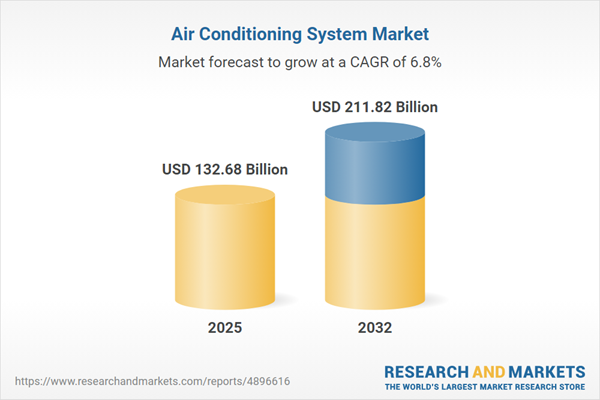Speak directly to the analyst to clarify any post sales queries you may have.
The air conditioning system market is undergoing significant transformation, driven by complex regulatory changes, evolving sustainability expectations, and diversified consumer demand across global regions. Senior executives require actionable insights to navigate technology shifts and capture growth in an increasingly competitive and regulated environment.
Market Snapshot: Air Conditioning System Market Growth and Trends
The air conditioning system market grew from USD 124.68 billion in 2024 to USD 132.68 billion in 2025. It is on track to maintain a compound annual growth rate (CAGR) of 6.84%, expected to reach USD 211.82 billion by 2032. The sector reflects heightened demand across residential, commercial, and industrial sectors, supported by innovations in system efficiency and sustainability initiatives. This growth underscores the expanding role of air conditioning systems as vital infrastructure for climate control in both developed and emerging economies.
Scope & Segmentation: Diversified Offerings Across Product, Technology, and Region
The global research report thoroughly segments the air conditioning system market, allowing stakeholders to evaluate targeted strategies:
- Product Types: Central air conditioning systems, room air conditioning systems, ducted, packaged, split systems, wall-mounted units, and window units
- Technologies: Inverter and non-inverter technology
- Cooling Capacities: 2-5 tonnes, above 5 tonnes, below 2 tonnes
- Components: Compressors, evaporators, heat exchangers
- Refrigerant Types: R-22, R-32, R-410A, R-600A
- Energy Efficiency: Non-star rated systems, star-rated systems
- Applications: Commercial (hospitality, offices, retail stores), industrial (manufacturing, warehouses), and residential (apartments, individual houses)
- Distribution Channels: Offline (brand showrooms, local dealers and distributors), online (brand-owned websites, eCommerce sites)
- Geography: Americas, Europe, Middle East & Africa, Asia-Pacific—including specific countries across every region
- Key Companies Analyzed: A Carrier Company, AB Electrolux, Amber Enterprises India Ltd., Blue Star Limited, Bosch Termotecnologia S.A., Captive-Aire Systems, Inc., Daikin Industries, Danfoss A/S, Emerson Electric Co, Fujitsu General, Gree Electric Appliances, Haier, Johnson Controls International, Lennox International, LG Electronics, Lindstrom Air Conditioning, Midea Group, Mitsubishi Electric, Panasonic Holdings, Rheem Manufacturing, Samsung Electronics, Sharp Corporation, Trane Technologies, Voltas by Tata Group, Whirlpool Corporation
Key Takeaways: Strategic Insights for Decision-Makers
- Innovative system architectures emphasize the use of advanced refrigerants and inverter-driven technologies to balance energy efficiency with regulatory compliance.
- Heightened emphasis on modularity and smart controls enables dynamic adaptation to fluctuating loads and facilitates predictive maintenance, reducing operational downtime.
- Supply chain strategies are shifting, with manufacturers focusing on regional partnerships, local production, and diversification to increase resilience.
- Growing integration of IoT, remote monitoring, and connected analytics empowers facility managers to optimize energy use and forecast system needs in real time.
- Shifts in consumer demand favor flexible procurement and service models that consider total cost of ownership and long-term sustainability, not just upfront investment.
Tariff Impact: Navigating Policy Shifts and Market Responses
- The introduction of 2025 tariffs on imported air conditioning components and systems is driving transformation in sourcing and supply chain footprint decisions.
- Many manufacturers are accelerating nearshoring, expanding local partnerships, or investing in domestic assembly to contain costs and reduce exposure to trade volatility.
- These developments are prompting novel contractual models, service diversification, and long-term planning adjustments in response to shifting price structures.
Methodology & Data Sources
This report leverages a blended research approach combining primary interviews across industry segments with secondary reviews of technical publications, regulatory documents, and market white papers. All data points are rigorously triangulated for reliability, with qualitative and quantitative analysis providing a comprehensive understanding of current market dynamics and trends.
Why This Report Matters
- Enables decision-makers to benchmark evolving technologies, policy impacts, and international market opportunities using structured, segmented insights.
- Provides actionable perspectives for optimizing sourcing, investment, and innovation strategies within a volatile regulatory and trade environment.
- Equips leadership teams to prioritize sustainable growth and resilience in supply chain and operational planning.
Conclusion
Senior executives can rely on this detailed air conditioning system market analysis to inform investment, product development, and global expansion strategies. The findings position leaders to capitalize on emerging opportunities while proactively addressing the challenges of regulatory evolution and competitive change.
Additional Product Information:
- Purchase of this report includes 1 year online access with quarterly updates.
- This report can be updated on request. Please contact our Customer Experience team using the Ask a Question widget on our website.
Table of Contents
3. Executive Summary
4. Market Overview
7. Cumulative Impact of Artificial Intelligence 2025
Companies Mentioned
The companies profiled in this Air Conditioning System market report include:- A Carrier Company
- AB Electrolux
- Amber Enterprises India Ltd.
- Blue Star Limited
- Bosch Termotecnologia S.A.
- Captive-Aire Systems, Inc.
- Daikin Industries, Ltd.
- Danfoss A/S
- Emerson Electric Co
- Fujitsu General Private Limited
- Gree Electric Appliances Inc.
- Haier, inc.
- Johnson Controls International plc
- Lennox International Inc.
- LG Electronics Inc.
- Lindstrom Air Conditioning by Wrench Group
- Midea Group
- Mitsubishi Electric Pvt. Ltd.
- Panasonic Holdings Corporation
- Rheem Manufacturing Company
- Samsung Electronics Co., Ltd.
- Sharp Corporation
- Trane Technologies plc
- Voltas by Tata group
- Whirlpool Corporation
Table Information
| Report Attribute | Details |
|---|---|
| No. of Pages | 183 |
| Published | November 2025 |
| Forecast Period | 2025 - 2032 |
| Estimated Market Value ( USD | $ 132.68 Billion |
| Forecasted Market Value ( USD | $ 211.82 Billion |
| Compound Annual Growth Rate | 6.8% |
| Regions Covered | Global |
| No. of Companies Mentioned | 26 |









